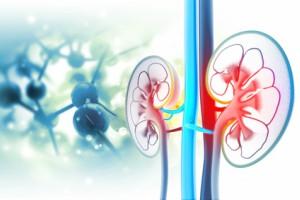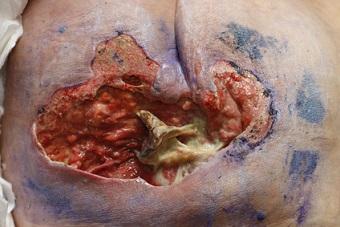Calciphylaxis: Prevention and Treatment of a Rare Disease
June 2, 2017
What is Calciphylaxis?
In patients with end stage renal disease (ESRD), there is a decreased renal clearance that causes an increase in phosphorus, then calcium, in the body. Elevation of these two electrolytes causes the parathyroid gland to secrete additional parathyroid hormone to compensate. This, however, leads to increased movement of phosphorus and calcium throughout the body.1 The result of this phenomenon is mobilized calcium deposits in the soft tissues. As this happens, circulation is compromised or blocked by the calcification within the microvasculature. Distal tissue becomes oxygen-deprived and quickly dies, or becomes necrotic.1 Necrotic areas, otherwise known as areas of eschar or simply "wounds," then develop, usually on the lower extremities, but can be anywhere on the body. A biopsy should be performed, usually by dermatology, to confirm the diagnosis of calciphylaxis.
Prevention and Treatment of Calciphylaxis
Primary prevention is defined as strategies that will prevent a person from getting a disease – things such as education, screenings, vaccines, regular wellness visits/physicals, and decreasing things that may be harmful to the body (such as secondhand smoke). With calciphylaxis, we can educate at-risk populations and screen people who may be at risk for ESRD, but there are no specific primary preventions for calciphylaxis itself. Once a patient has ESRD or any disease that could alter calcium and phosphorus metabolism, it automatically places them at risk for this disease. Secondary prevention happens after someone is already diagnosed with a disease. Secondary prevention strategies aim towards slowing the progression of a disease, doing things to prevent further damage, or promoting wellness. With calciphylaxis, secondary prevention would be pain management, infection prevention, and medical management of the underlying cause of the disease/imbalance. Focusing on quality of life and goals of care when managing these types of wounds is significant.
Patient/family meetings and palliative wound care should be considered. Tertiary prevention is somewhat of an extension of secondary prevention. Tertiary prevention focuses on those people with chronic disease such as heart failure, diabetes, cancer, chronic pain, vascular disease, neuropathy, and calciphylaxis. Tertiary prevention focuses on quality of life and maintaining functionality as tolerated, as well as rehab programs and support groups for those with a certain disease. Similar to secondary prevention, tertiary prevention focuses on pain management, preventing infection, and slowing disease progression. Sodium thiosulfate, a newer intravenous (IV) medication, has been shown to slow the progression of calciphylaxis in those with ESRD.2 A multidisciplinary team is beneficial when managing a patient with wounds secondary to calciphylaxis—pharmacy, nephrology, medicine, wound care, dietitians, palliative care, nursing, and therapy all have roles in management. Stay tuned for more on topical wound care, medical management/multidisciplinary approach, and pain management strategies specific to calciphylaxis.
References
1. Schmitz C, Reyes L. A case study, calciphylaxis: an exercise in human caring. Medsurg Nurs. 2009 Jul-Aug;18(4):239-41.
2. Raymond CB, Wazny LD. Sodium thiosulfate, bisphosphonates, and cinacalcet for treatment of calciphylaxis. Am J Health Syst Pharm. 2008 Aug 1;65(15):1419-29. doi: 10.2146/ajhp070546.[corrected, published erratum appears in Am J Health Syst Pharm 2010 Jan 1;67(1):8].
About the Author
Holly is a board certified gerontological nurse and advanced practice wound, ostomy, and continence nurse coordinator at The Department of Veterans Affairs Medical Center in Cleveland, Ohio. She has a passion for education, teaching, and our veterans. Holly has been practicing in WOC nursing for approximately six years. She has much experience with the long-term care population and chronic wounds as well as pressure injuries, diabetic ulcers, venous and arterial wounds, surgical wounds, radiation dermatitis, and wounds requiring advanced wound therapy for healing. Holly enjoys teaching new nurses about wound care and, most importantly, pressure injury prevention. She enjoys working with each patient to come up with an individualized plan of care based on their needs and overall medical situation. She values the importance of taking an interprofessional approach with wound care and prevention overall, and involves each member of the health care team as much as possible. She also values the significance of the support of leadership within her facility and the overall impact of great teamwork for positive outcomes.
The views and opinions expressed in this blog are solely those of the author, and do not represent the views of WoundSource, HMP Global, its affiliates, or subsidiary companies.












Follow WoundSource
Tweets by WoundSource